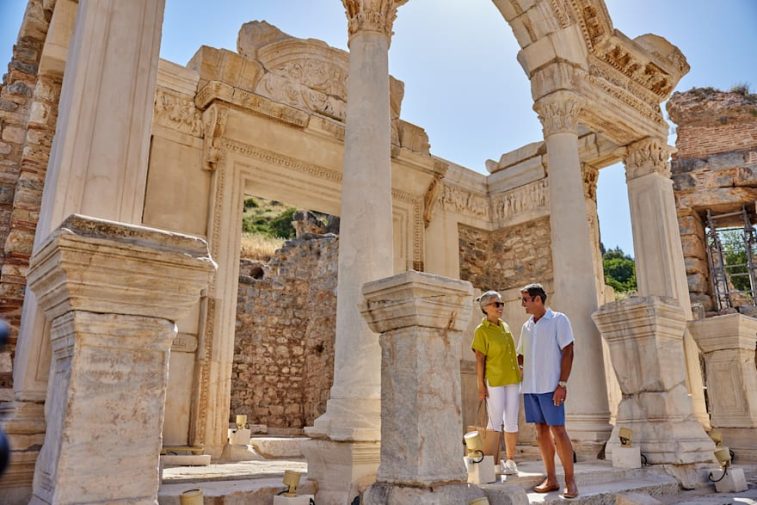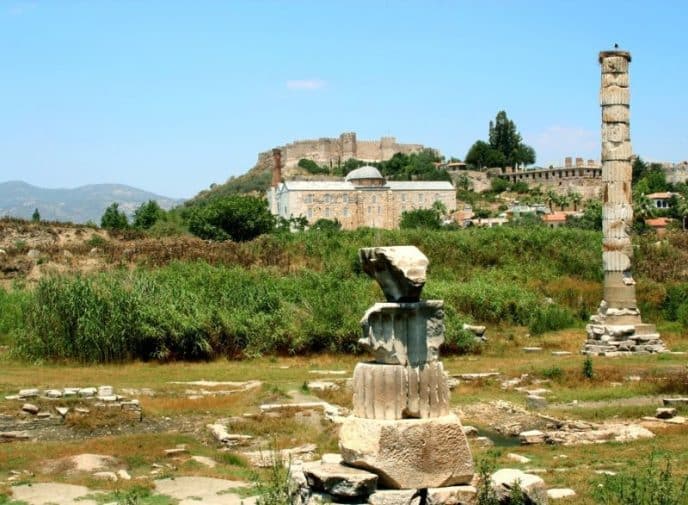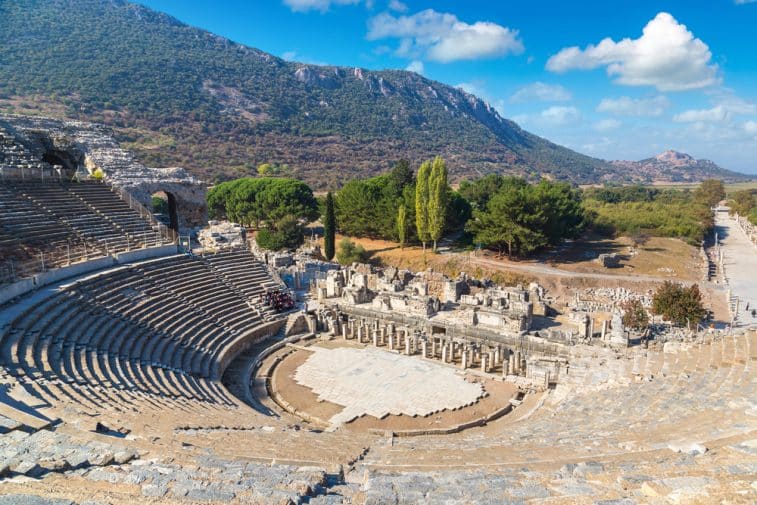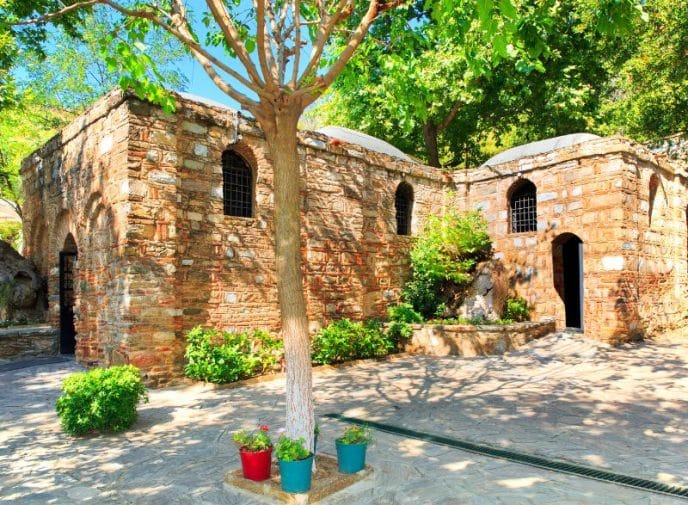Overlooking Turkey’s Icarian Sea are the dazzling remains of a city once so glorious it was fought over endlessly. Ephesus was founded by Greeks, expanded by Romans, invaded by Persians, Ottomans, Goths and Lydians, and hosts the soul of the Virgin Mary. Now it’s also revered by tourists. That’s because this UNESCO World Heritage Site is one of the best-preserved Greco-Roman cities on the planet.
Ephesus sits just 7 miles north of the port of Kusadasi and part of itineraries around the Greek Isles. Kusadasi is a beach resort town that’s even better known for its proximity to the ancient site. After docking here, on Turkey’s serene west coast, you can inspect Ephesus’ famed theater, temples, shrines, museum and the terrace houses of Bulbul Mountain. Here are five things to know about Ephesus.
Why Ephesus is so important to begin with

As you explore Ephesus, you walk over layer upon layer of civilization. Inhabited for at least 2,700 years, it developed into what UNESCO describes as “one of the largest and most powerful sanctuaries of the ancient world.” Originally a hub of the Ionians, an ancient Greek people, Ephesus was modernized by the Romans in the 2nd century B.C.
They made Ephesus the commanding harbor capital of their new territory of Asia. But Ephesus’ glory era ended in the 3rd century A.D., when it was razed by the Goths. Excavations in the last 150 years have uncovered archaeological sites which tourists now savor.
As they peer up at the two-story facade of the library, decorated by lofty columns, it may not be apparent just how vast it once was. In the 3rd century, Celsus was the third-largest library on the planet. Home to about 12,000 manuscripts, written on papyrus rolls, it was more than just a repository of knowledge. Celsus was an opulent, marble-laden landmark intended to showcase the riches of the Roman Empire. A Roman leader named Gaius Aquilus commissioned this library, beneath which he buried his father in a grand sarcophagus.
Ephesus hosts one of the Seven Wonders of the World

The Seven Wonders of the World with which most people are familiar are in fact the New Seven Wonders: Petra, the Colosseum, the Taj Mahal, Machu Picchu, Chichen Itza, the Great Wall of China and Christ the Redeemer. The original list, however, was compiled in the 2nd century and featured a glorious site at Ephesus: the Temple of Artemis
Built more than 2,500 years ago by King Croesus, the Temple of Artemis was an imposing structure, as visitors who wander the masterwork today can sense from its excavated remains. In treading this hallowed ground, tourists are following in the wake of ancient pilgrims from across the Mediterranean who for centuries descended on this temple.
The Great Theatre lives on

In our modern era, where so few things are built to endure, visitors to Ephesus may be delighted to find its Great Theatre is still an active venue, more than two millennia after it was erected. Its impressive acoustics once carried the voice of St. Paul the Apostle, who preached here in the 1st century A.D.
Here, walk the sacred path, known as the marble road, which connects Celsus with this large Hellenistic amphitheater, built into the side of Mount Pion.
Nearby: See the Virgin Mary’s final abode

Just a 20-minute drive from Ephesus (and many shore excursions include a visit to the sacred site as part of the tour), you can visit the small, weathered stone home where Jesus’ mother drew her last breath, according to local belief. Perched on Mount Koressos, and surrounded by trees, the House of the Virgin Mary is so significant that it’s hosted three Papal visits.
Here, stand in contemplation before its stone altar, adorned by a statue of Mary.
Windstar’s Destination Discovery Event: Dine amid ancient grandeur
Created as an addition to your daytime shore excursions while visiting Kusadasi, Windstar offers one of its Destination Discovery Events literally, right on the grounds of Ephesus.
“Arriving after hours, with no tourists,” says Chris Prelog, president of Windstar, “we were left to explore the ancient Marble Road. Soon a beautiful voice echoed from the amphitheater — a fellow passenger testing the amazing acoustics. It was the perfect prelude to a fabulous dinner and concert, a setting which cannot be duplicated.”
Indeed, as the sun slides behind ancient structures, live orchestral music echoes through this historic structure and past seated diners. Windstar Cruises guests have exclusive access to a five-course meal alongside this amazing ambience. (For travelers on Wind Star and Wind Spirit, the event takes place at Celsus; those on Star Legend and Star Pride are hosted on the Harbor Road, designed to showcase Ephesus as people arrived.)
Editor’s Note: Ephesus is typically visited on Windstar itineraries that call at both the Greek Isles and Turkey.




















































Is this video accurate about where the Ephesus dinner actually takes place? Inside the ruins as it shows in this video or outside in a new location on the street? We are going on the April 24th sailing and I’m curious.
Hi, Gail. My understanding (and we mention this in the story) is that For travelers on Wind Star and Wind Spirit, the event takes place at Celsus; those on Star Legend and Star Pride are hosted on the Harbor Road, designed to showcase Ephesus as people arrived. So the location depends on the size of the ship or, more accurately, the guest capacity….–Carolyn